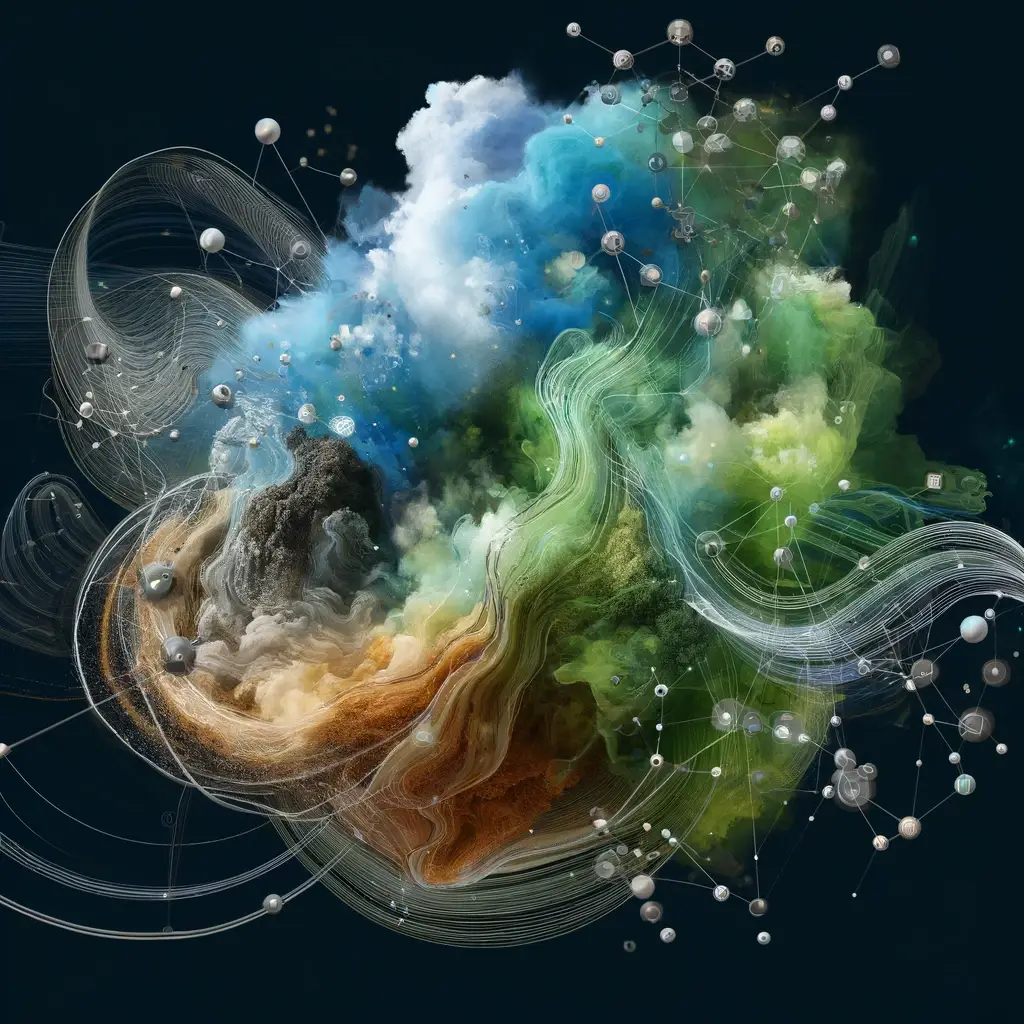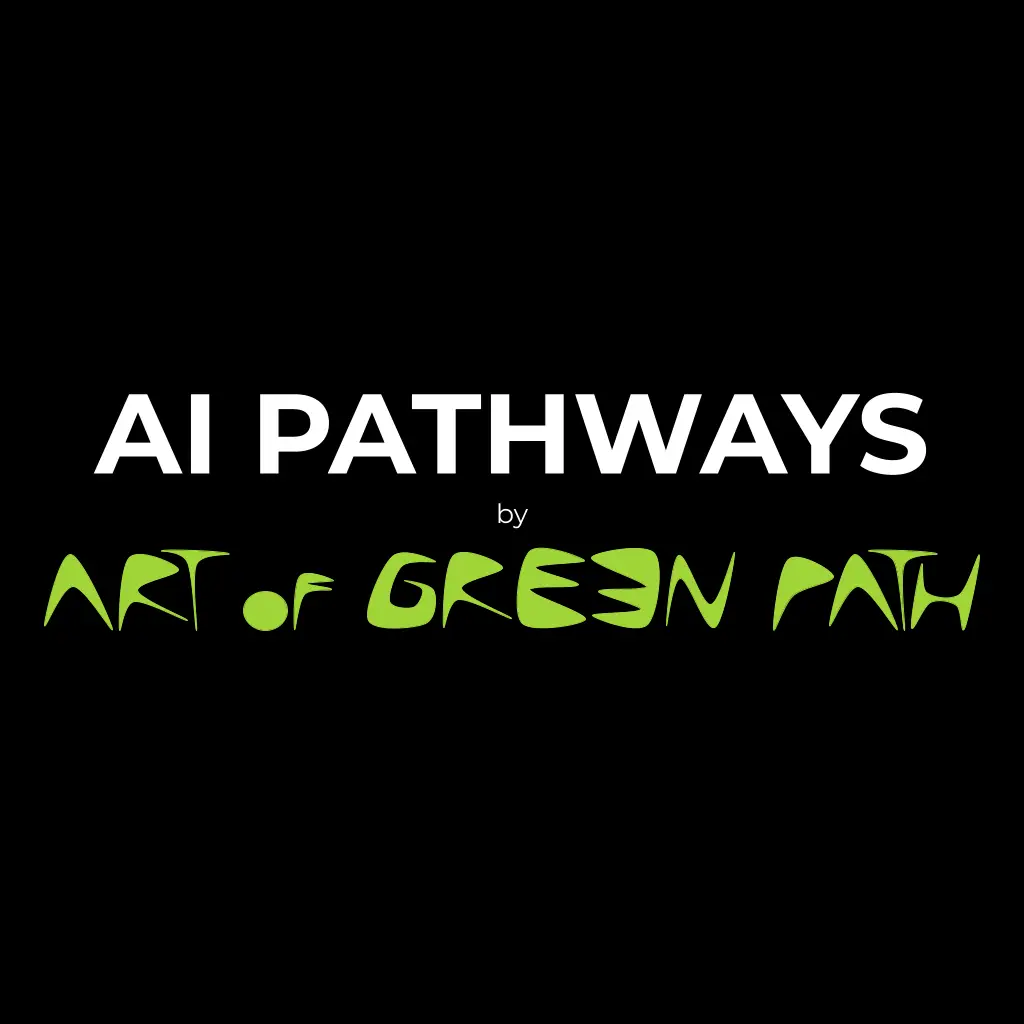Whether you need full guidance on how to use AI to elevate your business or you already have a clear idea of what you need – our comprehensive creative approach can help you with all phases like AI understanding, AI education, AI creation, AI ecosystem design and AI implementation.
From AI readiness assessment and AI opportunities recommendation over AI strategy and usage of generative AI for business innovation and automation.
Art Of Green Path and Roman Kos are your trustful partners in AI innovation.
To provide a foundational understanding of AI, covering its basic concepts, types, applications, and the impact it has across various industries.
Clear, accessible explanations of AI and its core principles.
Insights into the practical applications and advantages of AI in different sectors.
Resources for further exploration of AI tools and technologies.
Before: Unclear or basic understanding of what AI entails.
After: Comprehensive grasp of AI fundamentals, its applications, and advantages.



Key Message: AI is not just a technological innovation; it’s a transformative force reshaping our world.
Impact: Embrace AI’s potential while being mindful of its ethical implications.
Simplified Explanation: AI is like a smart assistant that learns and improves over time, helping us solve problems and make decisions.
Opportunities: AI can enhance personal productivity, creative pursuits, and problem-solving.
Risks: Being aware of AI’s limitations and potential biases is crucial.
Real-World Connection: From recommending movies on Netflix to optimizing routes in Google Maps, AI is already part of your daily routine.
Personal Solution: Use AI to streamline tasks and make informed decisions in everyday life.
Balanced View: While AI promises significant advancements, it also poses challenges like job displacement and privacy concerns.
Personal Responsibility: Stay informed and advocate for responsible AI development.
Empowerment Message: You have the power to shape how AI impacts your life and society.
Call to Action: Embrace AI as a tool for personal growth and social betterment, while being proactive in understanding and addressing its challenges.
Welcome to the fascinating world of Artificial Intelligence (AI), where machines aren’t just tools but collaborators, transforming how we live, work, and think. AI’s journey began as a visionary concept in science fiction, but today, it’s a dynamic and evolving reality. Understanding AI begins with its definition: AI is a field of computer science dedicated to creating machines capable of performing tasks that typically require human intelligence. This encompasses learning, problem-solving, pattern recognition, and decision-making.
AI is often used interchangeably with machine learning and deep learning, but they aren’t the same. AI is the umbrella term for machines mimicking human intelligence. Machine learning, a subset of AI, involves algorithms that enable machines to improve at tasks with experience. Deep learning, a further subset of machine learning, uses layered neural networks to analyze various factors in data, imitating how the human brain operates.
AI can be categorized into four types, each representing a different level of machine intelligence:
AI is no longer just a theoretical concept. It’s a part of our daily lives. Reactive machine AI is seen in game-playing bots and simple customer service chatbots. Limited memory AI powers more sophisticated systems like predictive text and voice assistants like Siri and Alexa.
In conclusion, AI is a diverse and rapidly evolving field. It’s not just about machines replacing human tasks but augmenting our capabilities and creating new opportunities for innovation and efficiency. As we continue to explore AI, we’ll delve deeper into how it works, its applications, and its future potential. Stay tuned for the next chapter where we’ll demystify the world of AI algorithms.
In the heart of every AI system lies a crucial component: the algorithm. An algorithm in AI is a set of rules or instructions designed to solve problems or perform specific tasks. These are the decision-making frameworks that enable AI systems to process data, learn from it, and make predictions or decisions. Think of them as the recipe that AI systems follow to make sense of the information they receive.
AI algorithms vary widely, each tailored to different tasks. There are algorithms for sorting data, for pattern recognition, for optimization, and more. Some common types include:
The process of an AI algorithm typically involves three key steps:
One of the most vital functions of AI algorithms is pattern recognition. They can identify patterns in data that are imperceptible to humans. This capability is crucial in areas like medical diagnosis, where algorithms can detect diseases from imaging data with high accuracy.
Algorithms also make decisions based on the data they process. These decisions can range from something as simple as flagging an email as spam to something as complex as determining the best route for delivery logistics.
Examples of AI Algorithms in Action
Algorithms are the building blocks of AI systems, enabling them to perform a wide range of tasks with efficiency and accuracy. Understanding how these algorithms work helps us appreciate the intricacies of AI and prepares us for more advanced AI concepts. In our next chapter, we’ll explore the exciting world of machine learning and deep learning, where these algorithms play a pivotal role in enabling machines to learn and evolve.
Machine learning (ML) is where the real magic of AI begins to unfold. It’s a subset of AI where machines are given the ability to learn and improve from experience without being explicitly programmed. ML is about algorithms learning from data, identifying patterns, and making decisions with minimal human intervention.
Deep learning, a subset of machine learning, mimics the workings of the human brain in processing data and creating patterns for decision making. It’s based on neural networks, which are algorithms modeled on the human brain’s structure and function.
Machine learning isn’t just a futuristic concept; it’s already here. From personalized Netflix movie suggestions to Amazon’s product recommendations, machine learning algorithms are becoming a part of our everyday life.
While machine learning can process and analyze data far beyond human capabilities, it is not without limitations. The quality of data and the way it’s used can significantly impact the outcomes. Biased or poor-quality data can lead to inaccurate or unethical results.
Machine learning and deep learning represent significant strides in the field of AI, enabling machines not just to compute, but to learn and evolve. As we delve further into AI’s potential, these technologies offer exciting possibilities for innovation and efficiency. In the next chapter, we will explore how AI permeates our daily lives, often in ways we might not even realize.
Artificial Intelligence (AI) is no longer just a subject of science fiction or a distant future; it’s a reality that permeates our daily lives. From the moment we wake up to when we go to bed, AI influences various aspects of our routine, often in ways we might not immediately recognize.
Smartphones and Virtual Assistants: AI powers virtual assistants like Siri, Alexa, and Google Assistant, making life more convenient through voice commands for tasks like setting reminders, playing music, or getting weather updates.
Home Automation: Smart home devices like thermostats, security cameras, and lights use AI to learn from your preferences, enhancing comfort and energy efficiency.
Streaming Services: Platforms like Netflix and Spotify use AI to analyze your viewing and listening habits, providing personalized recommendations that align with your tastes.
Social Media: Algorithms in social media platforms curate your feed, showing content more likely to interest you, and even suggest friends you may know.
GPS and Maps: AI algorithms process vast amounts of data to provide real-time traffic updates and optimal routes in navigation apps like Google Maps and Waze.
Autonomous Vehicles: While still in development, self-driving cars are a prime example of AI’s potential to revolutionize transportation, making it safer and more efficient.
Personalized Shopping Experience: E-commerce platforms like Amazon use AI to recommend products based on your search history and previous purchases.
Chatbots and Customer Service: AI-powered chatbots provide instant customer service, answering queries and offering solutions without human intervention.
Wearable Technology: Fitness trackers and smartwatches use AI to monitor health metrics like heart rate and sleep patterns, providing insights into your health and fitness regime.
Telemedicine and Diagnostics: AI is increasingly used in healthcare for diagnostic tools, like analyzing X-rays or identifying potential health risks through data analysis.
Automation of Routine Tasks: AI tools in workplaces automate routine tasks like data entry, freeing up time for more complex tasks that require human creativity and problem-solving.
Enhanced Decision-Making: AI-driven data analysis helps businesses make informed decisions, predicting market trends and customer behavior.
The integration of AI into everyday life demonstrates not just technological advancement but a shift in how we interact with our environment. AI has made significant strides in making our lives more convenient, efficient, and personalized. As we continue to embrace AI in various aspects of life, it’s essential to be aware of its impact and the ethical considerations that come with it. In the next chapter, we delve into the benefits of AI, exploring how it enhances efficiency, accuracy, and innovation across different domains.
Simplified Explanation: Generative AI is a type of AI that can create new content, from text and images to videos and music. It’s like an AI artist and writer, capable of generating original, creative works.
ChatGPT was widely seen as the fastest-growing consumer internet app of all time after its launch nearly a year ago, notching an estimated 100 million monthly users in just two months.
ChatGPT, GPT-4, Midjourney, Bard, Claude, Microsoft Copilot and other AI tools can already do all these complex functions below and a lot more.
Real-World Connection: From personalized shopping recommendations to AI-generated music playlists, generative AI is enhancing user experiences across various platforms.
Awareness: With the power to create realistic content comes the risk of misuse, like deepfakes or misleading information.
Responsibility: Users and creators must be ethical in using generative AI, ensuring authenticity and transparency.
Empowerment Message: Generative AI opens a world of creative and analytical possibilities, transforming how we see and interact with content.
Call to Action: Utilize generative AI to enhance creativity and efficiency in your work and personal life, while advocating for responsible use to maximize its benefits.
Artificial Intelligence (AI) is much more than a technological marvel; it’s a tool that enhances various aspects of both personal and professional life. This chapter explores the diverse benefits AI brings, demonstrating its role as a catalyst for efficiency, accuracy, innovation, and personalization.
Customized Experiences: AI’s ability to analyze vast amounts of data enables the delivery of personalized services and products. This is visible in the tailored recommendations on platforms like Netflix and Amazon, which adapt to individual user preferences.
Enhanced User Engagement: By understanding user behavior and preferences, AI can create more engaging and relevant experiences, whether in marketing campaigns, website interactions, or mobile applications.
New Solutions to Complex Problems: AI’s problem-solving capabilities enable it to tackle complex issues, from climate change modeling to optimizing logistics in supply chain management.
Creative Endeavors: AI is not just for analytical tasks; it’s also being used in creative fields. AI algorithms can generate art, music, and even write poetry, opening new avenues for human-AI collaboration in creativity.
Access to Information and Services: AI-powered tools like voice recognition and language translation services break down barriers, making information and services more accessible to people with disabilities or those speaking different languages.
Inclusive Products and Services: AI can help design products and services that cater to a diverse range of needs and preferences, promoting inclusivity.
Data-Driven Insights: AI’s ability to analyze large datasets helps businesses and organizations make informed decisions, based on trends and patterns that might not be evident to human analysts.
Predictive Analytics: In sectors like retail, finance, and healthcare, AI’s predictive analytics can forecast trends, consumer behavior, and potential risks, aiding in proactive decision-making.
The benefits of AI are multifaceted, touching every aspect of life and work. By enhancing efficiency, accuracy, and personalization, driving innovation, and improving decision-making, AI is not just a technological tool but a key component in shaping a more efficient, creative, and inclusive future. As AI continues to evolve, its potential to benefit various facets of human life is limitless. In the next chapter, we will address common misconceptions about AI, demystifying the technology and exploring its ethical use.
Artificial Intelligence (AI) often generates as much uncertainty as it does excitement. Common misconceptions about AI can lead to unfounded fears or unrealistic expectations. This chapter aims to address these misconceptions, highlighting the need for responsible governance, cooperation, and ethical considerations, especially in light of potential risks such as job displacement and the development of Artificial General Intelligence (AGI).
Reality: AI is a tool, not a panacea. It excels at processing data and identifying patterns but lacks human qualities like empathy and moral judgment. AI’s effectiveness is contingent on the quality of data and the context of its application.
Future: AI is becoming increasingly better in solving many types of problems and its computing power is exponentially growing so AI will undoubtedly overcome humans abilities in probably few years.
Reality: While AI automation will displace many jobs, it will also create new opportunities in sectors like human-AI interactions, AI maintenance, programming by using natural languages, and complex data analysis. The key lies in adaptability and continuous learning to stay relevant in an AI-augmented job market.
Human Values: Creativity, critical thinking and emotional intelligence will still remain unique to humans and widely used in human connections and interactions. Genuine human care about the world we live in will stay relevant and needed.
Risk Management: There’s a need for policies that support workforce transition, including retraining programs and educational initiatives.In addition, some form of universal basic income would need to be implemented in society, as maybe 30% of people will otherwise be without basic means.
Reality: AI algorithms themselves are not biased, but they can reflect and amplify existing biases in the data they are trained on. It’s crucial to use diverse, unbiased datasets and continually monitor AI systems for biased outcomes.
Governance and Ethics: Implementing ethical guidelines and governance frameworks for AI development and usage is essential to prevent and mitigate bias.
Self-Improvement and Feedback Loops: AI is learning not only by human guidance but also through own trails and errors. By collecting lots of different data, calculating them extremely fast and using them in new ways in transformer and diffusion algorithms, and instantly tracking human reactions and needs – all this creates an extremely powerful feedback loop of learning and improvement. This process will never stop, as we humans are pretty limited in our skills and capabilities.
AI development impacts everyone and requires a coordinated global effort to manage its benefits and risks effectively. International cooperation can help standardize ethical guidelines and ensure AI’s benefits are distributed equitably.
AGI Concerns: AGI, a hypothetical AI that possesses the ability to understand, learn, and apply its intelligence broadly and flexibly like a human, raises significant concerns about control and safety.
Safeguards: Developing AGI responsibly involves creating robust safety measures, transparency in research, and open dialogue about its potential impacts.
As AI becomes more integrated into society, instilling human values in AI systems becomes crucial. This involves programming AI to understand and adhere to ethical principles and societal norms.
Efforts like incorporating ethical decision-making frameworks into AI systems and engaging multidisciplinary teams in AI development are key steps.
Addressing misconceptions about AI and acknowledging its potential risks and limitations is crucial in harnessing its power responsibly. By understanding AI’s capabilities, embracing adaptability in the workforce, fostering international cooperation, and committing to ethical AI development, we can navigate the challenges and maximize the benefits of this transformative technology. The next chapter will delve into how AI aligns with sustainable practices, ensuring its development and application contribute positively to society and the environment.
As we delve deeper into the 21st century, Artificial Intelligence (AI) continues to evolve, promising to reshape every aspect of our lives. From enhancing day-to-day convenience to solving complex global challenges, the future of AI is a tapestry of vast potential and significant responsibility. This chapter explores the trends, potential advancements, and ethical considerations shaping the future trajectory of AI.
The future of AI must be guided by strong ethical principles and governance to avoid misuse and ensure it benefits all of humanity. This includes addressing issues like privacy, bias, and control over AI systems, particularly as they become more powerful.
AGI, or AI that possesses general, human-like intelligence, remains a significant yet controversial goal. While it offers incredible potential, it also comes with unprecedented challenges and risks, making its responsible development and regulation paramount.
Future AI is expected to collaborate more seamlessly with humans, augmenting human capabilities rather than replacing them. This collaboration could lead to new forms of creativity, problem-solving, and innovation.
AI will become more ingrained in our daily lives, making technology more intuitive, personalized, and efficient. From smart cities to AI in home appliances, its presence will be felt more profoundly and beneficially.
The future of AI is both exhilarating and daunting. It promises to bring about revolutionary changes in how we live, work, and interact with the world. However, its trajectory depends on balanced development, considering both its potential and its challenges. By prioritizing ethical development, focusing on human-AI collaboration, and addressing societal challenges, AI can be a force for good, driving humanity towards a more intelligent, sustainable, and equitable future. The journey of AI is far from complete, and its next chapters are ours to write.
As we conclude this exploration of Artificial Intelligence (AI), it’s clear that we are not just observers but active participants in the AI era. The journey into AI is not a distant sci-fi scenario; it’s a present-day reality, continually evolving and reshaping our world. Whether you’re a tech enthusiast, a professional in any field, or simply a curious individual, AI is a transformative force you can engage with, learn from, and contribute to.
Continuous Learning: The rapid evolution of AI calls for ongoing education and adaptability. Embracing lifelong learning will enable you to stay abreast of AI advancements and understand how they impact your life and work. Explore our other AI Guides.
Career Opportunities: AI opens new career paths and transforms existing ones. Whether it’s in AI development, ethical AI governance, or AI applications in various sectors, there are burgeoning opportunities for those prepared to dive in.
Responsible Use: As AI becomes more integrated into our lives, it’s vital to use this technology responsibly, considering its impact on society, the environment, and future generations.
Advocacy for Ethical AI: Being informed about AI allows you to advocate for its ethical development and application, ensuring that AI benefits humanity as a whole.
Solving Complex Problems: AI offers unprecedented tools for addressing complex global challenges, from climate change to healthcare. Your engagement with AI could contribute to these solutions.
Enhancing Daily Life: On a personal level, AI can enhance your daily life, from optimizing your health and productivity to enriching your learning and entertainment experiences.
Participation and Voice: Your interaction with AI, feedback, and choices can help shape the development of AI technologies. Public opinion and user behavior are crucial in guiding AI’s trajectory.
Collaboration and Community: Engaging in communities focused on AI – whether local or online – can provide opportunities for collaboration, learning, and influencing the direction of AI development.
Your journey with AI is one of discovery, learning, and impact. As AI continues to advance, your role in this journey becomes ever more crucial. Whether through personal development, professional engagement, ethical advocacy, or community involvement, your interaction with AI can contribute to a future where technology and humanity progress in harmony. Remember, the future of AI is not just about what it can do for us but what we can do with it. Embrace this journey with curiosity, responsibility, and a vision for a better world.
As you explore all of our other AI Guides, AI Services, AI Solutions and Art Of Green Path’s vision, we hope you’ll be inspired by the potential of AI to drive meaningful change. Now, we invite you to take the next step in this transformative journey.
Dive into our AI-Personalized Path Finder, Virtual AI Assistants, and AI Generated Future Scenarios. Discover how AI can enhance your personal and professional life in alignment with sustainable practices.
Whether you’re an individual seeking growth or an organization aiming for sustainable AI innovation, our tailored services are here to guide you.
Stay informed about the latest developments in AI and sustainability by subscribing to our AI PATHWAYS newsletter. Receive insights, success stories, and updates on new features and services.
Participate in our interactive workshops and events to connect with like-minded individuals and experts in the fields of AI and sustainability.
We value your experiences and insights. Share how AI has impacted your journey towards sustainability and purpose, and your story could inspire others.
Follow us, join the conversation, and spread the word about sustainable AI. Your voice can amplify the message and create a larger impact.
Your opinions and suggestions are crucial for us. Provide feedback on our tools and services to help us continuously improve and innovate.
If you represent an organization or group aligned with our mission, let’s explore potential collaborations and partnerships to further the cause of ethical and sustainable AI.
Start Today: Visit our Four Paths, develop your ideas further, consult with our experts, and begin integrating AI into your journey towards a sustainable future. Remember, every step counts, and together, we can make a significant difference.
Our Personalized Consulting & Coaching Services are tailor-made for Entrepreneurs, Impact Startups, Executives, Visionary Leaders, Business Owners, Innovators, and Professionals. We offer transdisciplinary guidance, AI strategy development, reinvention, and recommendations geared towards creating impact, fostering sustainability, driving growth, and catalyzing transformation in the AI-driven sustainable future. Our goal is to empower you to thrive in an ever-evolving landscape. Learn More!
Do you need direct help developing your business idea or creating your personal brand or harnessing the power of digital marketing or using ChatGPT in a creative and highly useful way? I offer my 1:1 Services and Solutions – from short engagements to deep immersions – check out all eight groups of them to find exactly what you need and when you need it. Learn More!
We unite AI, business and creative expertise
We are passionate about developing the best AI solutions for you
We offer highly personalized and customized services
We establish positive, long-term business relationships

Leverage AI for content creation and digital marketing. Identify areas where AI can enhance your content strategies and create detailed plans for integration.
Enhance your marketing efforts with AI-powered content creation.

Learn how to use Generative AI for innovation, research, planning, content creation, and marketing.
Unlock the potential of AI for your business.

Assess your existing data and develop tailored AI solutions. Gain data-driven insights and a personalized AI solution plan.
Tailored AI solutions specific to your business needs.

Unique combination of education, consultancy, data analysis, content creation, automation, integration and training for your specific case.
You get exactly what you need, in the shape and delivery you want.

Schedule a free 30-minute consultation to discuss your business challenges and explore AI opportunities.
Gain initial insights and recommendations tailored to your specific needs.
I help companies transform themselves using artificial intelligence
As a creative thinker, AI consultant, impact entrepreneur, and lifelong learner, I discover innovative ways to increase my positive social and environmental impact by engaging directly with the world’s most pressing problems through AI business innovation and transformative consulting and coaching.
My mission is to empower businesses and professionals to use AI for good while improving life for people and taking care of the environment.
Don’t wait! Harness the full power of AI now and adapt to an AI-powered future!
In the free Your Self Discovery Guide, you can explore interrelated topics like love, happiness, confidence and finding yourself and how they influence your personal growth.
In direct communication with me, you can understand your situation and confidently plan your desired future.
In the free Your Life Motivation Guide, you can explore interrelated topics like motivation, health, overcoming challenges and connecting to nature and discover how they inspire your adventurous spirit for change.
Through direct communication with me you can understand your opportunities and focus on their realization.
In the free Your Career Discovery Guide, you can explore interrelated topics like ideas, career goals, choices and creativity and discover how they drive your desired career change.
Through 1:1 consultancy and coaching you can match your real needs with your desired future career.
In the free Your Life Change Guide you can explore interrelated topics like life goals, purpose, reinvention and life change and find the direction you need.
Through focused personalized coaching, you can discover your purpose and ways to live it fully.
Your Self Discovery Guide introduces the premium program Path Of Awareness – which is the whole journey of self-growth in 7 modules with guiding, journalling and coaching.
Learn more about Four Paths to make your desired leap into the life you love that does good.
Your Life Motivation Guide introduces the premium program Path Of Exploration – which is the whole journey of life exploration in 7 modules with guiding, journalling and coaching.
Learn more about Four Paths to make your desired leap into a life of happiness and contribution.
Your Career Discovery Guide introduces the premium program Path Of Invention – which is the whole journey of career reinvention in 7 modules with guiding, journalling and coaching.
Learn more about Four Paths to make your desired leap into the best career for you.
Your Life Change Guide introduces the premium program Path Of Fulfillment – which is the whole journey of life reinvention in 7 modules with guiding, journalling and coaching.
Learn more about Four Paths to make your desired leap into the life of big positive impact
Our FOUR PATHS Transformative Program is an interactive AI-powered self-guiding experience where individuals and professionals looking for direction and purpose as they prepare themselves for AI-powered future.
The Art Of Green Path is an original concept and philosophy emphasizing the importance of personal creativity, conscious choice, co-creation and a deep appreciation for nature in creating a sustainable and desirable future. By embracing this philosophy, we can make positive and meaningful contributions to the world around us and build a better future for ourselves and the planet.
Art Of The Green Path’s FOUR PATHS are both visionary and practical, as they encourage you to pursue your aspirations and goals while also being mindful of the impact of your actions on the environment, on people and all living creatures and on future generations.
I have created this transformative program to inspire you and motivate you to become more in harmony with your inner self and more mindful of your creative life potential while developing profound connections with natural systems and all life. If you are looking for better ways to live your only life, these programs are for you! Learn More!
If you find this concept intriguing and vital and wonder how Art Of Green Path can help you:
to get your first personalized answers and sign up for valuable, inspiring content
to get the inspiration, motivation and guidance you need to create the career and life you love
to solve your urgent and strategic challenges in focused time
I want to inspire you to take your life back into your own hands, especially now in the age of AI.
I want to motivate you to do something bold, remarkable and meaningful (maybe as a first in your family or community) and prepare yourself for an AI-powered future.
I want you to dare speak openly about your struggles, doubts and leaps because the active path is the only path of growth.
I want to take care of nature, not only through your lifestyle but also in business decisions and business transformations with AI so you create a positive impact on social and environmental dimensions too.
Finally, I want you to inspire other silent, oppressed, unaware humans to choose life full of meaning, love, co-creation, collaboration and contribution.
I believe, everybody should find the courage to pursue their own path in business and life.
Roman Kos / Art Of Green Path founder
Art of Green Path is a platform dedicated to helping professionals navigate AI-powered future, business transformation, AI upskilling, AI customized solutions, together with previous topics like self-discovery, motivation, career change, and life transitions.
Our transformative journey hugs all dimensions of business, well-being, healthy lifestyle, creative and meaningful career and sustainable future with helping and contributing values. You can get guidance and support through personalized coaching and consulting sessions, expert advice, AI solutions and transformative AI-driven hands-on experiences.
Our approach is rooted in the belief that everyone has the power to create positive change in their lives, and we are committed to helping our clients unlock their full potential in harmony of AI and nature. So whether you’re seeking to overcome obstacles, clarify your goals, or cultivate a more profound sense of purpose and fulfillment, Art of Green Path can help.
Explore our free content and premium courses today and take the first step towards a more empowered and fulfilling life.
Executives and Leaders: To embrace digital transformation and pioneer an AI-powered future for your visionary organization.
Entrepreneurs and Innovators: To engage in strategic business transformation and harness artificial intelligence and digital marketing to drive impact.
Individuals and Professionals: To navigate personal growth, explore career change, and embark on career reinvention.
Coaches, Consultants, and Educators: To enhance your practice with AI tools and a sustainability-centered approach.
Activists and Community Builders: To champion sustainability, foster impactful community engagement, and work towards a regenerative future.
Executive AI Consultation
One-to-one consultation, brainstorming sessions, hands-on exercises, holistic view, business and entrepreneurial perspective
AI Strategy
Analysis of business goals and AI opportunities, business transformation, AI tools for sales and marketing, recommended AI use cases, AI-driven processes
AI Education
Personalized sessions, online workshops, team training, ChatGPT and other AI tools, AI models comparison and selection, employee motivation, productivity and creativity
AI Data Analysis
Internal data analysis and structuring, innovative insights, process transformation and automation, competitor analysis,
AI Content Creation
Prompt design, text generation and optimization, multimedia content, interaction design, AI-enhanced web, social media content, PR and communication
AI Business Solutions
Custom AI applications, automated AI solutions, advanced chatbots, system integration, secure and safe AI implementation, long-term optimization and upgrades
Innovation: Driving forward-thinking solutions and creative advancements.
Sustainability: Committed to promoting environmentally friendly practices.
Positive Impact: Focusing on social good and improving well-being.
Ethical AI: Ensuring transparency, fairness, and ethical standards in all AI applications.
Client-Centric: Providing tailored solutions and building long-term partnerships.
We partner with businesses and organizations committed to making a positive impact.
Our ideal clients include companies that:
Value Sustainability: Focus on environmental protection and sustainable practices.
Champion Innovation: Lead in technological advancements and creative solutions.
Promote Well-Being: Improve lives through visionary business, social good and community engagement.
Embrace Ethical Practices: Prioritize ethical AI implementations.
Seek Long-Term Partnerships: Desire ongoing collaboration and growth with AI.
Subscribe to our newsletter AI PATHWAYS by Art Of Green Path for curated and inspiring insights on the connections between AI, business and the future.
